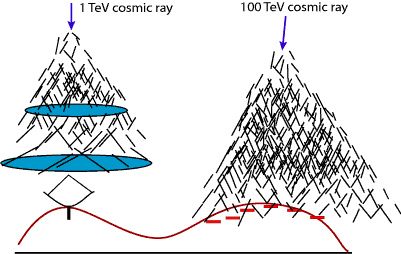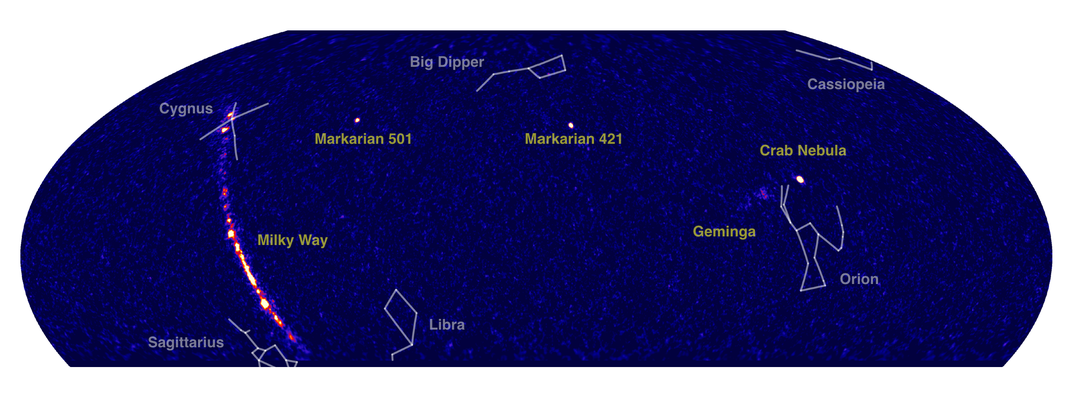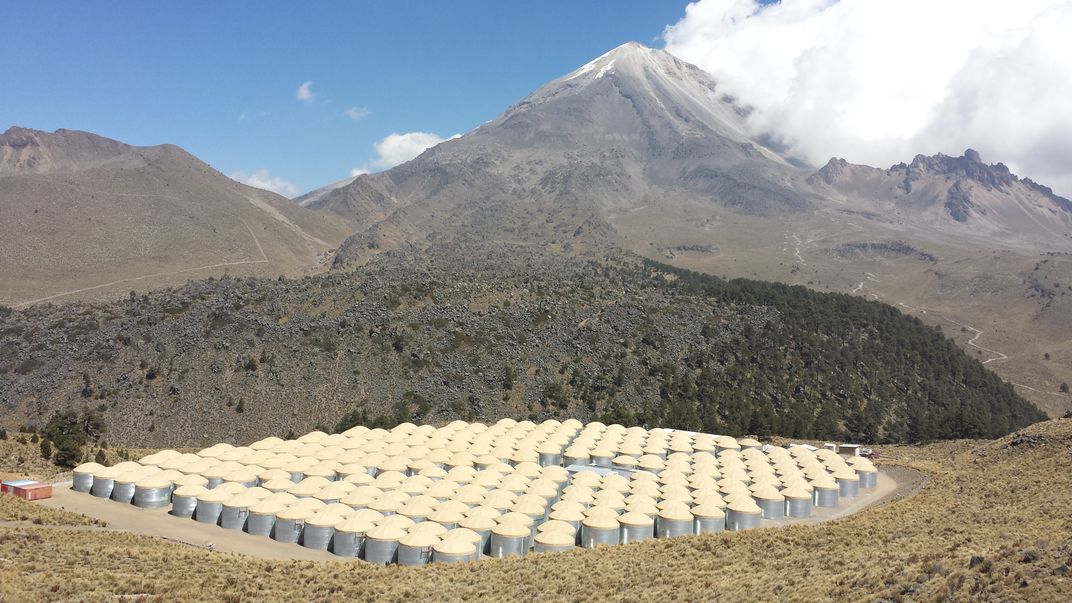The Hunt for High-Energy Photons Takes Place From a Mountaintop in Mexico
A new telescope built from water tanks might help answer some of the biggest questions in astronomy
The air over your head is alive with invisible showers. Powerful particles from space are constantly hitting the atmosphere above you, generating a subatomic cascade that shoots downward at near light speed. Figuring out where these downpours originate and what they tell us about the universe is the job of the High-Altitude Water Cherenkov (HAWC) observatory a telescope consisting of 300 giant tanks of purified water placed near the summit of the Sierra Negra volcano in Mexico.
HAWC’s goal is to find the highest-energy phenomena in the cosmos; including exotic stars, supermassive black holes, and annihilating dark matter. Phenomena such as these produce gamma rays, photons with more than a trillion times the energy of the optical light we see with, and cosmic rays, charged atomic nuclei with energies up to seven times that of the protons smashed together at the Large Hadron Collider. The origins of both remain shrouded in many mysteries, which is why HAWC constantly monitors a large part of the sky in the hope of unraveling a few.
When an ultra-high-energy particle enters Earth’s atmosphere and crashes into an air molecule, the resulting reaction produces new subatomic particles. Each of these contains tremendous energy and so they continue smashing and reacting and producing more particles in an ever-widening avalanche that ends up spreading out in a circle roughly 100 meters across by the time it reaches the ground. This particle shower passes through the telescope’s tanks traveling faster than the speed of light in water (which is about three-quarters its speed in a vacuum), creating the optical equivalent of a sonic boom—a burst of ultraviolet light known as Cherenkov radiation. By characterizing exactly how and when the particles encounter the array of purified water tanks, researchers can determine where in the sky the source is located.
Approximately 20,000 such showers are recorded every second at HAWC but almost all are cosmic, not gamma, rays. Because cosmic rays are charged, their flight path through the universe is altered by magnetic fields, meaning their origin points can’t be determined. Gamma rays are much rarer—HAWC sees about 1,000 of these a day—but they point in a straight line back to their sources. Previous gamma ray telescopes usually needed to be aimed at specific spots on the sky, often only after researchers have been alerted to some high-energy phenomena occurring there. Because HAWC stares out into the universe at all times, it has a better chance of picking up these rare flashes.
Completed in March 2015, the observatory just recently released its first year of data —a map of the sky revealing about 40 super-bright sources, many from within our Milky Way galaxy. “These are not run-of-the-mill stars,” said physicist Brenda Dingus of Los Alamos National Laboratory, spokesperson for HAWC.
Most are supernova remnants, the aftermath of the powerful explosion that occurs during the death of a giant star. As the shock waves from these explosions expand outward, they crash into surrounding gas and dust at high speeds, generating gamma radiation—a process that can continue for thousands of years. The HAWC team hopes to discover supernova remnants at various stages of their evolution and combine their data with data from other telescopes working at different wavelengths to figure out the details of this complex process. Because supernova remnants have powerful magnetic fields, they trap and accelerate charged particles, creating cosmic rays. Most of the cosmic rays we see are thought to originate in such places but they can also be produced by pulsars—rapidly spinning super-dense neutron stars emitting a beam of radiation—and black holes orbiting one another. HAWC will help researchers determine the total power output of all these different cosmic particle accelerators.
The HAWC data also contains several bright objects that are outside the galaxy. Because they’re so far away, these sources must be shining like floodlights in the universe. Some are active galactic nuclei, young galaxies whose central supermassive black hole is feasting on a huge glut of gas and dust. As the matter spins around the black hole, it gets heated up, releasing colossal jets of radiation. HAWC has seen these structures flare up periodically, but exactly why this occurs remains unknown.
The observatory also hopes to spot gamma-ray bursts, the most energetic phenomena in the known universe. Thought to occur when a supermassive star collapses into a black hole, these explosions release the same amount of energy in a few seconds as our sun will over the course of its entire life. Because they’re so transient, it’s been difficult for scientists to study them but HAWC—which is observing the sky constantly—is expected to see at least a couple per year.
Then there is the truly revolutionary stuff HAWC could potentially observe. “Dark matter would be the coolest thing to find,” said Dingus.
While scientists can see this strange material’s gravitational effects in the universe, dark matter produces no electromagnetic radiation and so doesn’t show up in ordinary telescopes. But some theorists speculate that dark matter particles could crash into one another and annihilate, a process that should generate gamma rays. In places like dwarf spheroidal galaxies, which are made almost entirely of dark matter, this annihilation should be constantly occurring. So far, no one has seen significant gamma radiation coming from these faint, small galaxies but new ones are being discovered all the time, raising the possibility of finally cracking open one of the biggest mysteries in astronomy.
The longer HAWC stares out into the universe, the deeper and more detailed its observations will become. The initial run of the observatory is currently scheduled to end in 2020. “But if we see something cool, maybe we’ll run for longer,” said Dingus.




